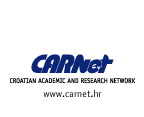

|
||
 |
||
 |
||


| Authors: Miroslaw Kupczyk, Rafal Lichwala, Norbert Meyer, Bartek Palak, Marcin Plociennik, Maciej Stroinski, Pawel Wolniewicz, Poznan Supercomputing and Networking Center, Poland | | Full
paper | Presentation
| |
Abstract
Introduction
In this work, we present a current status of development and integration
of Migrating Desktop and corresponding grid tools. Migrating Desktop
(MD) is an advanced GUI, which allows working with grid resources, it
hides the complexity of the grid middleware and frees the user from
knowing where the resources physically reside. This facility is not
only a gui for well-known Globus commands, it offers much more: flexible
personalised working environment, scalability and portability, set of
tools, single sign-on mechanism, Roaming Access Server (RAS) interfaces,
support for multiple grid infrastructure. The more detailed outline
is described here.
The Migrating Desktop overview
A number of Grid middleware projects are currently working on user interfaces
for interaction with grid
applications, however due to the dynamic and complex nature of the Grid,
efficient job submission and job management is still difficult to ordinary
scientists. Through its user- and application-centric approach, the
Migrating Desktop brings new quality to High Performance Computing (HPC)
user interfaces. Our solution is a complete, production-deployed software
environment with special focus on interactive grid applications. These
applications are simultaneously compute- as well as data-intensive and
are characterized by the interaction with a person in a processing loop.
This research was done under the EU CrossGrid project (IST-2001-32243).
The homepage of the Migrating Desktop encloses the tool, and user guide
[3]. Migrating Desktop is just a front end to Remote Access Server,
which intermediates between different grid middleware and applications.
The RAS offers a well-defined set of web-services that can be used as
an interface for accessing HPC systems and services (based on various
technologies) in a common, standardized way. All communication bases
on web services technology. This architecture provides an important
future direction with respect to the general acceptance of services
and protocols. General concept of MD was to provide the containers -
frameworks for plug-ins written by application developers. Such approach
allows increasing functionality in an easy way without need of architecture
changes.
It is possible to add various tools, applications and support visualisation
of different formats using that mechanism. As an example: MD on demand
loads from network appropriate plug-in for visualisation of nonstandard
graphics format file. That makes our product independent of specialized
tools designed only for specific application. MD supports different
kinds of accessing remote/HPC applications. We have focused mainly on
supporting frameworks for grid applications, unifying different interfaces
into one common solution. MD calls appropriate web services on the RAS.
The server job submission interface gives uniform access to different
resource brokers. Clients can submit all jobs with this interface and
then appropriate plug-ins are called to convert job description to the
specific language. Currently we are using plug-in for CrossGrid/DataGrid
resource broker to convert job description to JDL and Progress plug-in
to convert job description to XRSL. Grid
applications available for users are grouped in a user-friendly way
in a Job Wizard in the MD. This Wizard simplifies the process of specifying
parameters and limits, suggesting user defaults or recently used parameters.
The Wizard is responsible for proper preparation of the user's job and
consists of several panels. One panel is application specific plug-in
and the rest can be used to set job information, resource requirements,
files and environment variables. Application plug-in asks user for application
parameters and these parameters are passed to the command line later
on. For application developers that do not like to prepare plug-in we
created generic XML plug-in that interprets argument description given
in XML to a graphical form. Example of plug-ins is MD also allows running
remote Java tools. In contrast to grid applications that are submitted
to the resource broker, tools are Java applets downloaded from different
network localisations on demand. Some applications require a graphical
visualisation of job results. In our approach visualisators are tools
and they also
base on the Tool Plug-in.
Migrating Desktop bases on Java applet technology. It can be launched
using Java Webstart Technology or using web browser with appropriate
Java Plugin included in Java Runtime Environment (JRE). We base on Swing
libraries for designing graphical user interface, Java CoG Kit [4] version
1.1a with some extensions is being used as interface to Globus functionality
and Axis ver. 1.1 web services client for communication with Roaming
Access Server. As an server for webservices we use open-source servlet
container, Apache Tomcat version 4.1. During the presentation, the live
demo of the Migrating Desktop will be presented. The preliminary view
of this framework, as a current status of work is available [2].
References
1. M. Kupczyk, R. Lichwala, N. Meyer, B. Palak, M. Plociennik, P. Wolniewicz,
„Mobile Work Environment
for Grid Users", Across Grids 2003, LNCS 2970, pp. 132-138, 2004
2. http://ras.man.poznan.pl/crossgrid/md1.avi
3. http://wp3.crossgrid.org
4. G. von Laszewskia, I. Foster, J. Gawor, and P. Lane, .A java commodity
grid kit,. Concurrency and
computation: Practice and Experience, vol. 13, no. 8-9, pp. 643.662,
2001, http://www.cogkits.org/.